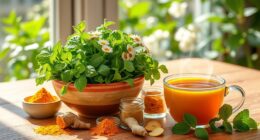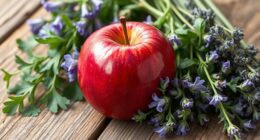We're excited to begin on our herbalism journey, and we're initiating with the basics. First, we'll choose beginner-friendly herbs like peppermint, lavender, and chamomile, and explore herbal preparations like teas, tinctures, and infused oils. Next, we'll establish our herb garden, opting for a sunny spot with well-draining soil. We'll invest in essential tools like stainless steel pots and cheesecloth, and prioritize sourcing high-quality, certified organic herbs. As we continue on this holistic path, we'll learn about herbal actions, create natural remedies, and develop safe practices, slowly building a routine that nurtures our bodies, minds, and spirits, and ultimately, a deeper connection with nature.
Key Takeaways
• Start with beginner-friendly herbs like peppermint, lavender, and chamomile for a safe and sustainable herbalism journey.
• Set up an herb garden in a sunny spot with well-draining soil to grow your own medicinal herbs.
• Invest in essential tools like stainless steel pots, cheesecloth, and mixing bowls for herbal crafting and preparation.
• Choose certified organic herbs from reputable suppliers for high-quality and safe herbal remedies.
• Educate yourself through beginner books and expert consultation to prioritize safe herbalism practices.
Understanding Herbalism Basics
As we explore the world of herbalism, let's start by defining what it's all about: herbalism is the study and practice of using herbs and plants to promote overall well-being. Herbalism is a holistic approach that aims to nourish the whole person – body, mind, and spirit.
We're not just talking about using herbs as a quick fix; we're talking about a long-term commitment to wellness. Herbalism is a practice that's been around for centuries, with roots in traditional medicine practices like Ayurveda and Traditional Chinese Medicine.
In Western herbalism, we focus on using herbs to support our health and prevent illness. As we investigate further into the world of herbalism, we'll discover the vast array of herbs available to us, each with its unique properties and uses.
We'll learn how to harness the power of herbs to create natural remedies, and how to incorporate them into our daily lives. By understanding the basics of herbalism, we're taking the first step towards a more holistic approach to health and wellness.
Choosing the Right Herbs

We're diving into the world of herbalism, and the next step is to choose the right herbs to get started, selecting beginner-friendly options that are safe, sustainable, and easy to incorporate into our daily lives.
As we begin to find our footing in plant medicine, we'll focus on 12 beginner-friendly herbs like peppermint, lavender, and chamomile. These herbs aren't only easy to work with but also gentle on our bodies, making them perfect for learning about herbalism.
When selecting herbs, we make sure they're safe for beginners and consider the sustainability of our choices, opting for organic or locally sourced options whenever possible. We'll explore different herbal preparations like teas, tinctures, or infused oils to incorporate these herbs into our daily routines.
To deepen our understanding, we can turn to recommended beginner books like 'Rosemary Gladstar's Medicinal Herbs', which provides valuable information on herb selection and usage.
Setting Up an Herb Garden

With our beginner-friendly herbs in hand, let's bring them to life by setting up an herb garden that thrives in a sunny location with well-draining soil. We'll start by choosing a spot that gets at least 4-6 hours of direct sunlight a day. Next, we'll prepare the soil by mixing in some organic matter to guarantee good drainage.
| Herb | Growing Conditions | Uses |
|---|---|---|
| Basil | Well-draining soil, full sun | Cooking, medicinal |
| Lavender | Dry soil, full sun | Medicinal herb, calming tea |
| Parsley | Moist soil, partial shade | Garnish, medicinal |
| Mint | Moist soil, partial shade | Tea, digestive aid |
| Chamomile | Well-draining soil, full sun | Medicinal herb, calming tea |
As we plant our herbs, we'll consider growing medicinal herbs like lavender, echinacea, and chamomile. If space is limited, we can use containers or opt for raised beds for better drainage. Regular watering, pruning, and harvesting will promote healthy growth and encourage our herbs to thrive. By following these simple steps, we'll be on our way to growing a lush and vibrant herb garden that will provide us with fresh herbs for cooking and medicinal use.
Essential Herbalism Tools

We stock our herbalism workspace with essential tools, including stainless steel or glass pots, double boilers, measuring cups, spoons, and funnels. These tools help us to create herbal remedies safely and efficiently.
Additionally, we recommend investing in cheesecloth, mixing bowls, and spatulas to further enhance our herbal crafting experience.
When it comes to storing our finished products, we like to get creative by upcycling containers. Not only does this promote sustainability in our herbal practice, but it also helps reduce waste.
Moreover, using organic essential oils in our DIY crafting can greatly enhance the quality and effectiveness of our herbal creations.
Sourcing High-Quality Herbs

When sourcing herbs, prioritizing quality is crucial, as it directly impacts the effectiveness and safety of our herbal remedies. As beginners, we want to make sure we're getting the best herbs for our health and well-being.
To do this, we can follow these guidelines:
- Choose certified organic herbs to guarantee high-quality and safe products.
- Look for sustainable sourcing to support ethical and eco-friendly practices.
- Research the supplier's reputation and transparency to ensure quality standards.
- Check for third-party testing to verify the purity of the herbs.
Preparing Herbs for Use

As we progress in our herbalism journey, we're now ready to explore the vital step of preparing our herbs for use.
We'll examine the various harvesting and drying methods that help preserve the potency of our herbs, as well as the best practices for storing our herbal remedies to maintain their effectiveness.
Harvesting and Drying Methods
To guarantee peak potency, we harvest our herbs early in the day, when the essential oils are most concentrated. This safeguards that our herbs retain their medicinal properties and flavor. After harvesting, we move on to the drying process, which is vital in preserving the herbs' potency.
Here are some essential tips for harvesting and drying herbs:
- Harvest early: Pick herbs in the morning, when essential oils are most concentrated.
- Dry naturally: Hang herbs upside down in a dark, well-ventilated area to prevent mold and maintain medicinal properties.
- Use a dehydrator or oven: For herbs with high moisture content, consider using a dehydrator or oven on low heat to expedite the drying process.
- Store properly: Store dried herbs in airtight containers away from sunlight and moisture to preserve their flavor and effectiveness.
Storing Herbal Remedies
Now that we've harvested and dried our herbs, we're ready to store them properly to maintain their potency and flavor. Storing herbal remedies correctly is vital to preserve their medicinal properties and guarantee they remain fresh for a longer period.
We'll store our dried herbs in airtight glass containers, away from heat and light, to maintain their potency and freshness. We'll also label these containers with the herb names and dates to track their freshness and usage.
For fresh herbs, we'll keep them in the refrigerator wrapped in a damp paper towel to extend their shelf life.
When it comes to herbal tinctures, we'll store them in dark glass bottles to prevent light degradation. Similarly, we'll store infused oils in dark glass bottles in a cool, dark place to preserve their medicinal properties.
Understanding Herbal Actions

We explore the fascinating world of herbal actions, where the intricacies of plant-based remedies unfold to reveal their profound effects on our bodies. As beginners in herbalism, understanding herbal actions is essential in choosing the right herbs for individual health needs. Herbalists rely on this knowledge to create effective herbal formulations that address specific health concerns.
Here are some common herbal actions we should know:
- Adaptogens: Help the body adapt to stress and promote balance.
- Nervines: Soothe and calm the nervous system.
- Diuretics: Increase urine production and help with fluid retention.
- Carminatives: Relieve digestive issues, such as bloating and gas.
Creating Herbal Remedies

As we explore the world of creating herbal remedies, we're excited to learn about the various ways to harness the healing power of plants.
We'll start by examining different herbal preparations, including teas, tinctures, and salves, and how they can be tailored to address specific health concerns.
From making soothing herbal teas to crafting natural skin care products, we'll uncover the art of creating effective herbal remedies that promote wellness and vigor.
Herbal Preparations Explained
Herbal preparations offer a world of possibilities for discovering bespoke remedies tailored to our specific health needs, enabling us to access the therapeutic potential of plants in a variety of forms. By understanding the different types of herbal preparations, we can reveal the unique benefits of each method and create remedies that cater to our individual health requirements.
Here are some of the most common herbal preparation methods:
- Teas: Infusing herbs in hot water to create a soothing brew.
- Tinctures: Extracting herbs in alcohol or glycerin for a concentrated liquid form.
- Salves: Infusing herbs in oils or beeswax for topical application.
- Oils: Using herbs to create therapeutic oils for skin and muscle relief.
Each method extracts different properties from the herbs, making them suitable for specific healing purposes. By exploring these different preparation methods, we can tap into the full potential of herbalism and create remedies that truly address our unique health needs.
Making Herbal Teas
Now that we've explored the various herbal preparation methods, let's brew up a soothing cup and explore the art of making herbal teas, a simple yet effective way to harness the medicinal properties of plants.
Herbal teas are a popular way to enjoy the benefits of herbs and plants for health and wellness. We can create herbal teas by steeping dried or fresh herbs in hot water to extract their medicinal properties. This allows us to tailor our teas to address specific health concerns or promote overall well-being.
Different herbs offer unique flavors and therapeutic properties when used in herbal tea blends. For instance, peppermint tea can soothe digestive issues, while chamomile tea can promote relaxation. Herbal teas can be a soothing and enjoyable way to incorporate herbal remedies into our daily routine.
Natural Skin Care
We can harness the power of plants to create natural skin care products tailored to our individual skin needs and preferences. By incorporating herbal remedies into our skin care routine, we can address various skin issues such as acne, eczema, and dryness.
Many herbs like calendula, lavender, and chamomile have soothing and healing properties beneficial for the skin.
Here are some benefits of using herbal skin care products:
- Customization: We can create products tailored to our individual skin needs and preferences.
- Gentle and soothing: Herbal skin care products are often free from harsh chemicals, making them gentle and suitable for sensitive skin.
- Natural and effective: Herbal remedies can promote healthier, radiant skin naturally.
- Chemical-free: By using herbal remedies, we can avoid harsh chemicals found in many commercial skin care products.
Safe Herbalism Practices

As we embark on our herbalism journey, it is important to prioritize safe practices to avoid potential risks or adverse effects. We must make sure the herbs we choose to explore are safe for beginners to use and consider the sustainability of our herb choices to support ethical herbalism practices. By doing so, we can incorporate selected herbs into our daily life for practical application and learning.
To further our knowledge, we can choose beginner-friendly books for self-education on safe herbalism practices. Here are some key takeaways to keep in mind:
| Safe Herbalism Practices | Why It Matters | How to Achieve |
|---|---|---|
| Choose safe herbs | Avoid adverse effects | Research and consult with experts |
| Consider sustainability | Support ethical practices | Choose locally sourced and organic options |
| Start with beginner-friendly herbs | Ease into herbalism | Begin with gentle herbs like peppermint or chamomile |
| Prioritize practical application | Reinforce learning | Incorporate herbs into daily life |
| Educate yourself | Stay informed | Read beginner-friendly books and consult with experts |
Building a Herbalism Routine

By incorporating herbalism into our daily routines, we can harness the power of plant medicine to transform our well-being and deepen our connection with nature.
As we learn more about herbalism, we can practice herbalism in a way that resonates with our unique needs and lifestyle.
To build a consistent herbalism routine, we can start by:
- Starting small: Begin with simple practices like drinking herbal tea or using herbal skincare products.
- Creating a sacred space: Designate a special area in our home or cultivate a small herb garden to connect with nature.
- Experimenting with remedies: Try different herbal formulations to find what works best for our body's needs.
- Tracking our journey: Keep a journal to document our experiences with different herbs, noting their effects and any insights gained.
Frequently Asked Questions
How Do I Start Learning Herbalism?
We begin by acknowledging our curiosity about herbalism and taking the first step: self-education. We immerse ourselves in reputable resources, devouring books and online content, like YouTube tutorials, to grasp the basics of herbal properties and applications.
As we learn, we experiment, testing herbs and observing their effects, gradually refining our understanding. Importantly, we remember to consult medical professionals when needed, ensuring a safe and informed journey into the world of herbalism.
What Is the First Step in Becoming a Herbalist?
As we start on the journey to become herbalists, the first step is to lay the groundwork by familiarizing ourselves with the basics of herbalism.
We need to understand the properties and uses of different herbs, which means researching and exploring various herbs.
This foundation is essential, like planting a seed that will grow into a strong herbalism practice.
What Is Herb 101 Basics of Herbalism?
We're diving into the fundamentals of herbalism, and Herb 101 is where it all begins. This foundation course teaches us the basics of herbalism, covering topics like herbal terminology, plant anatomy, and the principles of herbal medicine-making.
We learn about different herbal preparations, such as teas, tinctures, and salves, and how to create them safely and effectively.
At What Point Can You Call Yourself an Herbalist?
We often wonder when we can confidently call ourselves herbalists.
Some may think it's just a matter of taking a few courses or reading some books. However, we believe that truly earning the title of herbalist requires more.
It involves completing formal training programs, gaining practical experience, and building a deep understanding of plant medicine.
Only then can we commit to ongoing learning, ethical practices, and promoting health and wellness through herbal remedies.
Conclusion
As we conclude our journey into the world of herbalism, we've gained a solid foundation to build upon. We've demystified the basics, selected the right herbs, and set up our own garden.
We've equipped ourselves with essential tools, sourced high-quality herbs, and grasped the complexities of herbal actions. With a solid grasp on safe practices and remedy creation, we're ready to incorporate herbalism into our daily routine.
As we continue to learn and grow, we'll tap into the full potential of herbalism, embracing a holistic approach to wellness.









